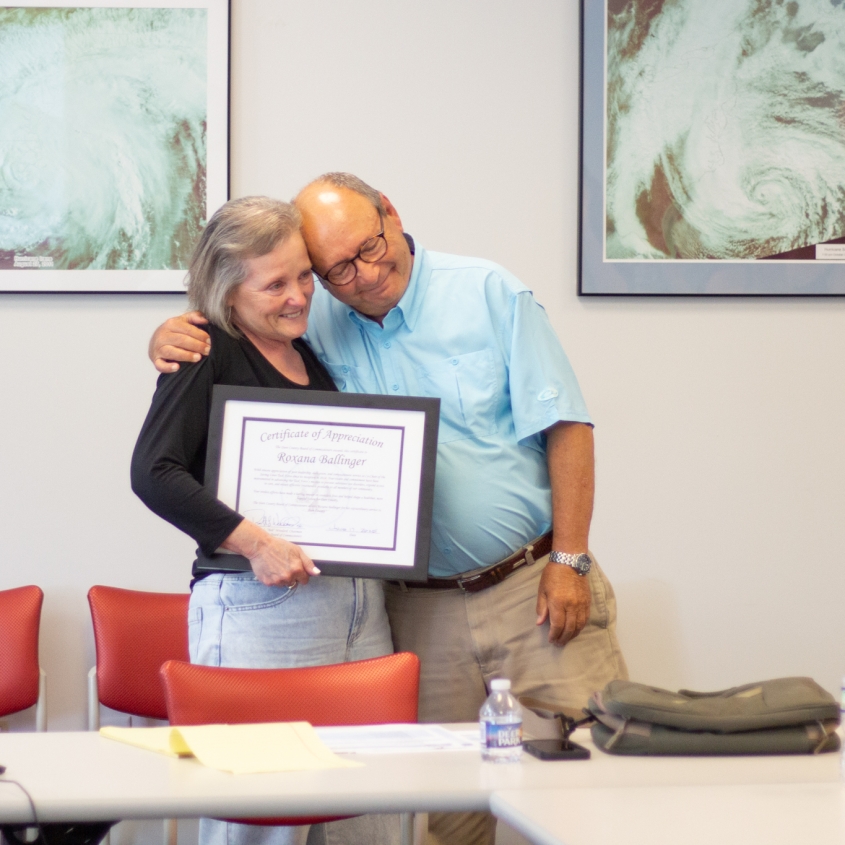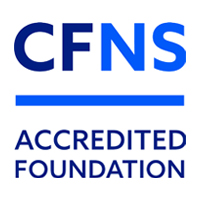‘It’s just evolved for the better’: Retiring and incoming Saving Lives Task Force co-chairs reflect on growth, accomplishments of task force
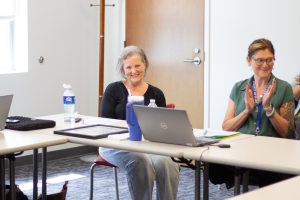
Roxana Ballinger, outgoing co-chair of the Saving Lives Task Force, smiles after receiving a certificate of appreciation for her service at her last task force meeting, Tuesday, June 17, in Manteo. Katy Haslar, the new co-chair following Ballinger’s retirement, is seen on the right. Photo courtesy of Corinne Saunders.
By Corinne Saunders
Editor’s Note: This story was produced with support from the Outer Banks Community Foundation. Outer Banks Insider is solely responsible for its journalism and maintains full editorial independence.
Staying consistent, relevant and flexible has led to the success of the Saving Lives Task Force, according to Roxana Ballinger.
At the end of June, Ballinger stepped down from her 11-year role as task force co-chair when she retired from the Dare County Department of Health and Human Services (DHHS). Katy Haslar, a task force participant since 2019, took over in her stead.
“Katy is the perfect person to take my place…I felt that a couple of years ago, when I started thinking about retirement,” Ballinger said in a video interview from Virginia Beach, Virginia, her hometown to which she returned.
Haslar and her husband, both of whom are in recovery, moved to the Outer Banks from Indianapolis, Indiana, in 2018 and together launched a local SMART Recovery program chapter. She met Ballinger as she began volunteering with task force initiatives.
“First, I was a volunteer, and we had this friendship, and then she became my supervisor when Dare County hired me to help run the program that we’re running today—so it’s kind of a cool evolution,” said Haslar, the human services program coordinator for Dare County DHHS.
When the Saving Lives Task Force formed in July 2014, Ballinger recalled some community hesitancy to embrace it and harm reduction strategies in general, and even some tension between different organizations. Through collaboration, education and respect, the task force has become more effective over time, in her opinion.
Haslar agreed.
“When I was first coming to these meetings, we were not getting naloxone out to all the places that we’re getting it out to today,” she said. “There was still that stigma, that whole, like, ‘Ohh…we don’t want naloxone or Narcan; we don’t need it in Dare County.’”
She credited the task force’s consistent efforts with breaking down those barriers, both widening the acceptance of harm reduction strategies and increasing the use of “person-first language,” meaning no longer calling people “addicts” or “drunks,” in the area.
“I’ve seen the stigma crumble,” Haslar said.
The task force helped establish and promote 10-12 Dare County DHHS harm reduction access points across the county. These businesses and agencies have dedicated areas for providing anyone with free information on recovery resources and harm reduction tools, such as naloxone and fentanyl test strips.
Since December, a new Mobile Recovery Unit has traveled around the county to designated stops providing the same, along with food distributions, health screenings, syringe services and in-person connections for future support toward recovery.
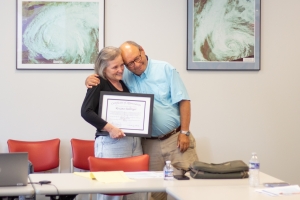
Wally Overman, Saving Lives Task Force co-chair, presents outgoing co-chair Roxana Ballinger with a certificate of appreciation at the Saving Lives Task Force meeting Tuesday, June 17, in Manteo. Photo by Corinne Saunders.
“I am just extremely proud of how we have evolved and stayed relevant to what is going on in Dare County with substance use,” Ballinger said. “It’s just evolved through the years, and it’s just evolved for the better.”
The goal of this work is to support people wherever they are. The task force wants to keep them alive and build relationships that will give them a contact for whenever they decide they’re ready for treatment, as recovery programs are only effective when it’s that person’s choice, Ballinger said.
She credited Wally Overman, task force co-chair and former Dare County commissioner, with originally wanting to pull people together to address substance use in the community.
“He’s the one who really had the vision for the task force,” Ballinger said. “We just started having monthly meetings and inviting everybody that had anything to do with substance use.”
Counselors, medical practitioners, treatment program workers, nonprofit staffers and community members at large have showed up, and kept coming. They share what they each are doing and identify both successful strategies and any gaps in the community that could be addressed.
“We just stayed steadfast with it because, you know, if you want to do something, you need to be consistent even if you have some naysayers out there,” Ballinger said.
The task force’s attendance hovered around 10 at first, and it averages around 30 now, with some meetings nearing 50 people, she said.
“We even had people from Currituck [County] come because Currituck really didn’t have anything [like this],” Ballinger said, adding that they are trying to start a similar effort.
“We have counties that call us frequently, wanting to know what we’re doing and wanting to talk to us…because what we’re doing is working,” Ballinger said.
As powerful, new-to-the-street drugs have been introduced into area drug supplies in recent years, like fentanyl and xylazine, getting feedback from across the community has been a vital tool.
“I think we’ve done an excellent job of staying relevant…and shifting, being fluid to change what we’re doing to meet that need,” she said, noting, “overdoses have dropped.”
Accidental drug overdose, usually from an opioid, is the No. 1 cause of accidental death in North Carolina, according to the North Carolina Department of Justice webpage on the opioid crisis.
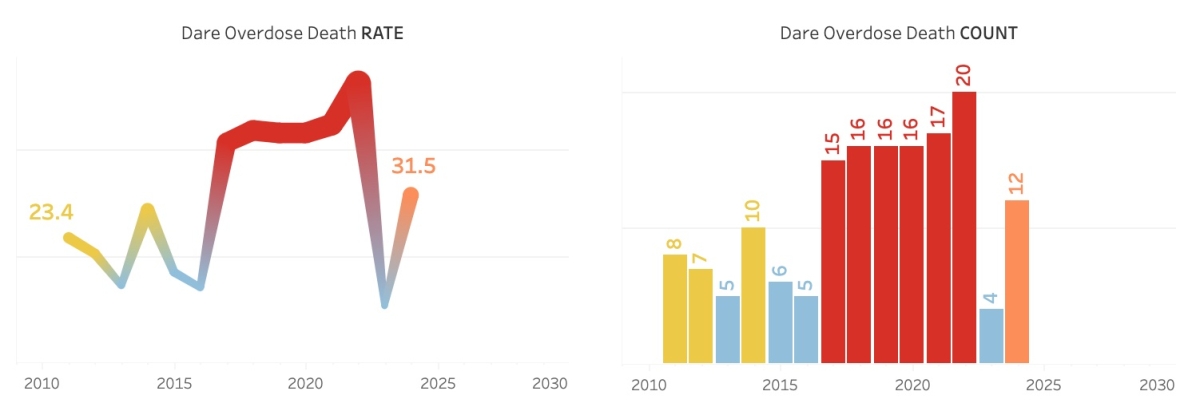
Dare County’s annual overdose death count rose across a six-year period, from five deaths in 2016 to 20 deaths in 2022, putting the county’s overdose death rate among the highest in the state from 2017-2022 and exceeding the statewide average rate in each of those years.
In 2023, Dare’s rate fell to among the state’s lowest, as four people died from overdoses—the lowest number recorded for the county since the North Carolina Department of Health and Human Services’ Division of Public Health overdose data set began in 2011.
Last year saw 12 overdose deaths, placing the county’s death rate in the high range and above the state average, but not in the highest bracket where it had been for previous years.
“There is no one silver bullet,” Ballinger noted. “It’s multiple strategies and initiatives that make the difference.”
She explained that addressing substance use requires work “from different angles all kind of going on at the same time.”
Dare County DHHS launched its ROSS (Recovery and Overdose Support Services) program with a full-time peer support specialist position even before the county began receiving opioid settlement funding in 2022, which now supports the program. Haslar is one of two peer support specialists at DHHS, among her many other roles.
Dare County is receiving over $6.4 million total in opioid settlement funds between 2022 and 2038, with a different amount distributed each year, according to the dedicated state website tracking the funding.
North Carolina Gov. Josh Stein, formerly state attorney general, was among the attorneys general nationwide that negotiated various opioid settlements that are paying out, each over a specific number of years. The task force creates the plan for the funds, which then goes to the county commissioners for approval.
The task force became a nonprofit and has also received four Outer Banks Community Foundation grants totaling over $25,000 since 2020—two for Recovery Court, one for the Mobile Recovery Support Unit, and one for its newsletter.
Recovery Court is an incarceration alternative program for people in recovery, and the grant was for “interactive, educational group workshops on life skills,” according to the Outer Banks Community Foundation.
“The diversity of grants awarded to the Saving Lives Task Force reflects the depth and complexity of the challenges facing our community,” Chris Sawin, Outer Banks Community Foundation president and CEO, said in a prepared statement. “Roxana, Wally and Katy have done a tremendous job building something truly unique—an active, collaborative network of providers and support systems addressing all aspects of substance use in Dare County.”
Overman presented a certificate of appreciation from the Dare County Board of Commissioners, signed by Chairman Robert “Bob” L. Woodard, to Ballinger at her last task force meeting, on Tuesday, June 17.
“Your vision and commitment have been instrumental in advancing the task force’s mission to prevent substance use disorders, expand access to care and ensure effective treatment is available to all members of our community,” Overman read aloud from the certificate at the meeting.
“Your tireless efforts have made a lasting impact on countless lives and helped shape a healthier, more hopeful future for Dare County,” he continued.
Ballinger noted that she is just a phone call away.
“The task force just needs to continue to stay relevant and innovative, which I have no doubt they will do,” she said.
To learn more about the Saving Lives Task Force, visit www.savinglivesobx.com.
For more information about opioid settlement funds across the state, visit https://ncopioidsettlement.org.

